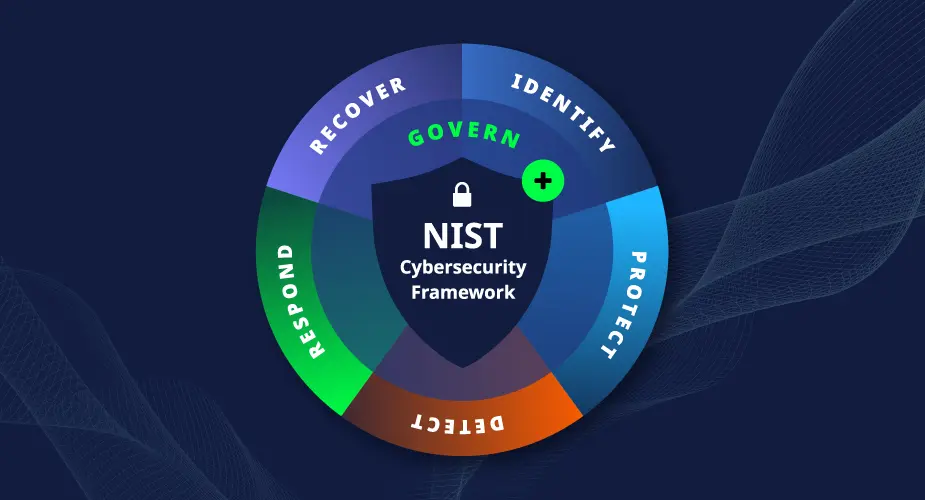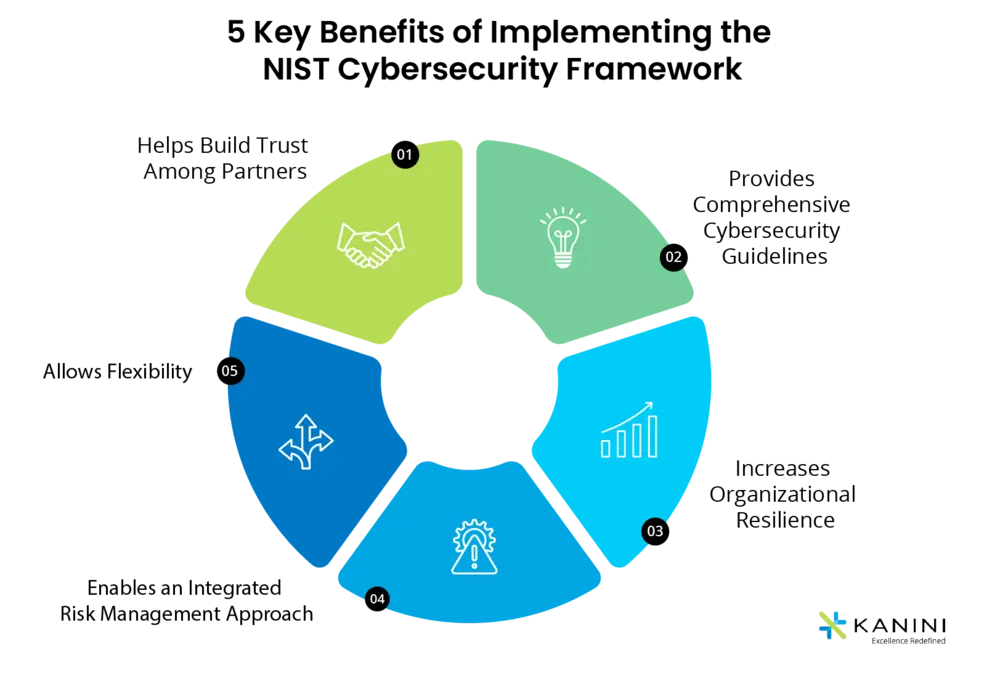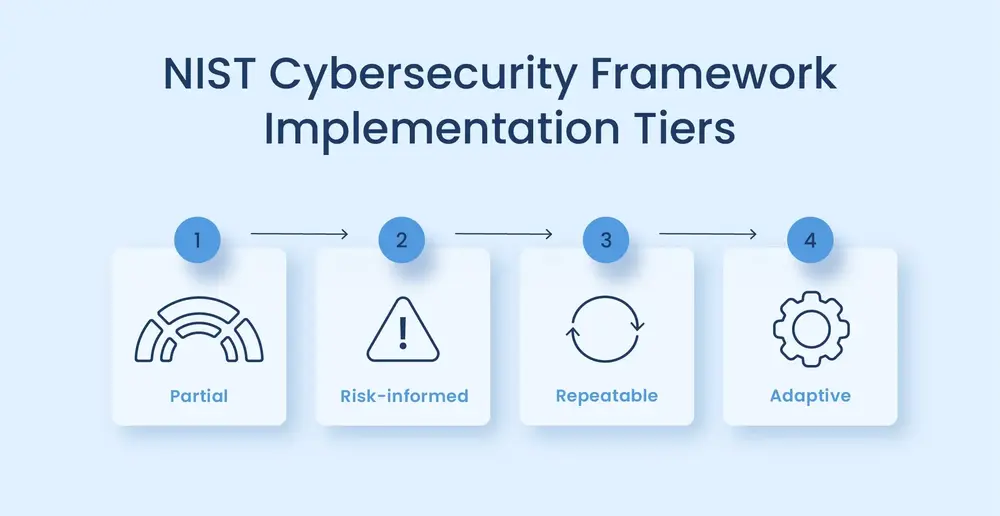The IT security Framework from the National Institute of Standards and Technology is a well-regarded and widely acknowledged set of guidelines aimed at helping businesses manage and mitigate cybersecurity risks.
This comprehensive framework gives a structured approach to identifying, protecting against, detecting, responding to, and recovering from cyber threats. Organizations can improve their safety posture and protect critical assets by adopting the NIST Framework for Cybersecurity.
Understanding the NIST Framework for Cybersecurity
The NIST Cybersecurity Framework includes three main elements: The Framework Core, Implementation Tiers, and Profiles. Each component serves a particular purpose and collectively contributes to the framework’s effectiveness.

Framework Core
The Framework Core gives a set of desired activities and outcomes.
It is organized into five concurrent and continuous functions:
- Identify: This function involves understanding the organization’s context, assets, business environment, and risk management strategy. Key activities include asset management, business environment assessment, governance, risk assessment, and risk management strategy.
- Protect: The Protect function focuses on implementing safeguards to ensure the delivery of essential infrastructure services. Activities include access control, awareness and training, data security, information security processes and procedures, maintenance, and protective technology.
- Detect: The Detect function involves developing and implementing activities to identify an event’s cause. Key activities include anomaly and event detection, continuous security monitoring, and detection processes.
- Respond: The Respond function includes developing and implementing activities to take action regarding a detected event. These activities include response planning, communications, analysis, mitigation, and improvements.
- Recover: The Recover function focuses on maintaining resilience plans and restoring any capabilities or services impaired by a safety incident. Activities include recovery planning, improvements, and communications.
Implementation Tiers
Implementation Tiers provide a mechanism for businesses to view and understand the characteristics of their practices.
The Tiers vary from Partial (Tier 1) to Adaptive (Tier 4), indicating the progression of an organization’s safety practices.
- Tier 1: Partial: Cybersecurity risk management practices must be formalized, and risk is managed ad hoc and sometimes reactively.
- Tier 2: Risk Informed: Risk management methods are approved by management but may not be accepted as organizational-wide policy.
- Tier 3: Repeatable: Risk management techniques are formally established and consistently applied across the organization.
- Tier 4: Adaptive: The organization adapts its practices based on lessons learned and predictive factors derived from previous and current activities.
Profiles
Profiles represent the alignment of the Framework Core with an organization’s requirements, risk tolerance, and resources.
A Current Profile indicates the safety outcomes achieved, while a Target Profile represents the desired state of safety capabilities.
Comparing these profiles helps organizations identify gaps and areas for improvement.
Benefits of the NIST Framework for Cybersecurity

Implementing it benefits organizations of all sizes and across various industries.
Improved Risk Management
By understanding and categorizing potential threats, organizations can develop targeted techniques to mitigate these risks effectively.
This proactive approach enhances the organization’s ability to prevent and respond to cyber incidents.
Enhanced Compliance
Adopting it helps organizations meet regulatory and industry standards. Many regulations and compliance requirements reference the NIST Framework as a benchmark for practices.
Implementing the framework can streamline compliance efforts and demonstrate a commitment to robust measures.
Increased Resilience
The framework’s focus on identifying, protecting, detecting, responding to, and recovering from cyber threats ensures that organizations are prepared for various scenarios.
This comprehensive approach enhances organizational resilience, enabling faster recovery and minimizing the impact of safety incidents.
Better Communication
This facilitates better communication among internal stakeholders, including management and technical staff, and external partners, such as vendors and regulators.
Clear communication is essential for effective collaboration and coordinated efforts.
Steps to Implement the NIST Framework for Cybersecurity

Successful implementation requires a systematic approach. The following steps outline the framework’s integration into an organization’s practices.
Establish Leadership Support
Leadership support is crucial for successfully implementing the NIST Framework for safety.
Leadership commitment ensures that adequate resources are allocated and that cybersecurity is prioritized across the organization.
Leadership should endorse the framework and promote a culture of safety awareness.
Conduct a Risk Assessment
The foundation of this framework is a comprehensive risk assessment.
Organizations should identify critical assets, assess potential threats and vulnerabilities, and determine the impact of various cyber incidents.
This assessment helps prioritize cybersecurity efforts and allocate resources effectively.
Develop a Current Profile
Creating a Current Profile involves mapping the organization’s existing practices to the Framework Core.
This profile provides a snapshot of the current state of cybersecurity and identifies areas that need improvement. It helps organizations understand their starting point and set realistic goals.
Define a Target Profile
The Target Profile represents the desired state of cybersecurity capabilities. When developing this profile, organizations should consider their risk tolerance, business objectives, and regulatory requirements.
The Target Profile serves as a roadmap for achieving improved practices.
Conduct a Gap Analysis
A gap analysis compares the Current and Target profiles to identify discrepancies. This analysis highlights areas where existing practices fall short of desired outcomes.
Organizations can use this information to prioritize initiatives and develop an action plan.
Implement Action Plans
These plans may include updating policies and procedures, enhancing security technologies, and providing additional employee training.
Regularly reviewing and updating these plans ensures continuous improvement.
Monitor and Review
Continuous monitoring and periodic reviews are essential for maintaining an effective cybersecurity posture. Regular audits and assessments help identify new risks and opportunities for improvement.
Challenges and Best Practices
Implementing the NIST Framework for cybersecurity can be challenging, but adopting best practices can help overcome these challenges.
Common Challenges
- Resource Constraints: Limited resources can hinder the implementation of comprehensive safety measures.
- Complexity: The breadth of the NIST Framework can be overwhelming for organizations without dedicated cybersecurity expertise.
- Resistance to Change: Employees may resist new processes and technologies, impacting the adoption of the framework.
Best Practices
- Prioritize High-Impact Areas: Focus on areas that significantly impact the organization’s security posture and address the most critical risks first.
- Leverage Existing Resources: Use existing tools like VPN for iOS, processes, and expertise to implement the framework effectively.
- Foster a Cybersecurity Culture: Promote a culture of cybersecurity awareness and encourage employees to take ownership of their role in protecting the organization.
- Engage Stakeholders: Involve stakeholders across the organization to ensure a comprehensive and coordinated approach to cybersecurity.
Mastering cybersecurity through the NIST Cybersecurity Framework involves understanding its components, recognizing its benefits, and methodically implementing its guidelines.
By integrating the framework into their cybersecurity practices, organizations can effectively manage risks, ensure compliance, and enhance their resilience against cyber threats. Adopting the NIST Framework for cybersecurity is a strategic investment in an organization’s long-term security and success.
Read More: 8+ Best TikTok Plugins for WordPress
Contact US | ThimPress:
Website: https://thimpress.com/
Fanpage: https://www.facebook.com/ThimPress
YouTube: https://www.youtube.com/c/ThimPressDesign
Twitter (X): https://twitter.com/thimpress


